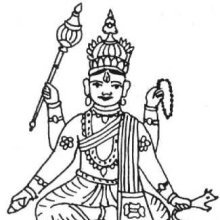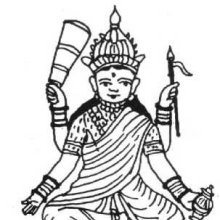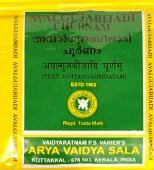White: 3 definitions
Introduction:
White means something in Hinduism, Sanskrit. If you want to know the exact meaning, history, etymology or English translation of this term then check out the descriptions on this page. Add your comment or reference to a book if you want to contribute to this summary article.
Images (photo gallery)
(+128 more images available)
In Hinduism
Natyashastra (theatrics and dramaturgy)
Source: Shodhganga: Elements of Art and Architecture in the Trtiyakhanda of the Visnudharmottarapurana (natya)1) The White colour (in Indian Dramas) is reserved for the Gods and Brahmins, as conveyed through the Aṅgaracanā division of Āhāryābhinaya: one of the four divisions of Abhinaya or “ways to convey or represent one’s emotion to others”, according to the Viṣṇudharmottarapurāṇa, an ancient Sanskrit text which (being encyclopedic in nature) deals with a variety of cultural topics such as arts, architecture, music, grammar and astronomy.—Aṅgaracanā meaning painting of limbs of different characters, also falls under the category of makeover. The Viṣṇudharmottarapurāṇa speaks that it should be done according to the caste, position, superiority and country of respective characters. As for example, this book suggests that gods should be white in colour; Brahmins should be white in colour like moon [...] etc. The Nāṭyaśāstra also agrees on it. This is important to note that this type of notes and rules give a social implication of the performance.
2) The White (colour) is denoted by the Sanskrit word Sita and is associated with Hāsya or the “comic sentiment”, which represents one of the nine kinds of Rasa (“soul of Drama”), according to the Viṣṇudharmottarapurāṇa.—The Viṣṇudharmottarapurāṇa says that hāsyarasa is generated from some irrelevant or funny conversations or attires which bring humour to the viewers’ mind and the viewers start laughing. [...] Hāsa is the sthāyibhāva of this sentiment. Sita i.e., white is the colour and Pramatha is the God of this sentiment.
3) The White color is associated with Catura-hasta: one of the twenty-two Single-hand Gestures (in Indian Dramas) (known as asaṃyuktahastas).—According to the Viṣṇudharmottarapurāṇa, some colours are pointed with the catura hand gesture. When the hand is raised in catura posture, it denotes white colour. When the hand moves in circular way and in semi-circular motion in caturahasta, it denotes yellow and red colour respectively. In compacted form it shows blue colour. When the hand is kept in normal position with caturahasta, it denotes black and the other remaining colours.

Natyashastra (नाट्यशास्त्र, nāṭyaśāstra) refers to both the ancient Indian tradition (shastra) of performing arts, (natya—theatrics, drama, dance, music), as well as the name of a Sanskrit work dealing with these subjects. It also teaches the rules for composing Dramatic plays (nataka), construction and performance of Theater, and Poetic works (kavya).
Vastushastra (architecture)
Source: Shodhganga: Elements of Art and Architecture in the Trtiyakhanda of the Visnudharmottarapurana (vastu)The White Color is recommended for those Stones that are used as a Material for the Construction of Temples, according to the Viṣṇudharmottarapurāṇa, an ancient Sanskrit text which (being encyclopedic in nature) deals with a variety of cultural topics such as arts, architecture, music, grammar and astronomy.—Finding of proper types of materials is one of the important aspects for any construction. Indian scriptures state that to procure the stones, the astrologer and the architect should go to mountain and examine the stones. In the Viṣṇudharmottarapurāṇa a proper examination of stone is suggested in this regard. In connection with temple building some specific colours of stones are also recommended. These are, for example the white colour.

Vastushastra (वास्तुशास्त्र, vāstuśāstra) refers to the ancient Indian science (shastra) of architecture (vastu), dealing with topics such architecture, sculpture, town-building, fort building and various other constructions. Vastu also deals with the philosophy of the architectural relation with the cosmic universe.
Shilpashastra (iconography)
Source: Shodhganga: Elements of Art and Architecture in the Trtiyakhanda of the Visnudharmottarapurana (shilpa)1) White (colour) is denoted by the Sanskrit term Śveta and represents one of the five primary colours in the ancient Indian tradition of Painting (citra), according to the Viṣṇudharmottarapurāṇa, an ancient Sanskrit text which (being encyclopedic in nature) deals with a variety of cultural topics such as arts, architecture, music, grammar and astronomy. In the Viṣṇudharmottarapurāṇa, five colours are regarded as the primary ones, e.g., White (śveta). Mixing of colours is a great technique used by the artists to make numerous shades of colours. A painter can create hundreds or thousands of colours by amalgamating the primary ones.
2) The White color is associated with various deites.—In the Viṣṇudharmottarapurāṇa, the attire, accessories, weapons, carrier, different colours etc. of the idols of different deities are projected which are taken for discussion here. It is clear that the book offers a great field of knowledge regarding the nuances of Indian art of Image making [e.g., the various colours for garments] during 10th–11th century A.D.
White colour of Varuṇa’s cloth.—According to the Viṣṇudharmottarapurāṇa, the idol of Varuṇa should be adorned with white cloths. On the other hand, the Kāśyapaśilpa as well as the Śilparatna accepts yellow colour for the dress of Varuṇa.
White colour of Agni’s attire.—Charcoal in heated form is red in colour. So it can be assumed that following this concept of the Ṛgveda, the Viṣṇudharmottarapurāṇa suggests red colour as the body complexion of the image of Agni. The Viṣṇudharmottarapurāṇa accepts smoky colour where as the Śilparatna accepts white colour for the attire of the god Agni.
White colour of Indra’s elephant.—Śakra is an epithet of Indra. According to the Viṣṇudharmottarapurāṇa, the image of Śakra or Indra should be golden in complexion and should wear blue garments. The statue of Śakra should be placed on an elephant which have four tusks. According to the Bṛhatsaṃhitā, the elephant of Indra should be white in colour.

Shilpashastra (शिल्पशास्त्र, śilpaśāstra) represents the ancient Indian science (shastra) of creative arts (shilpa) such as sculpture, iconography and painting. Closely related to Vastushastra (architecture), they often share the same literature.
See also (Relevant definitions)
Starts with (+256): White acacia, White african mahogany, White albizia, White alder, White alling, White angelica, White arum, White arum lily, White ash, White atractylodes, White babool, White babul, White baneberry, White bani, White bauhinia, White bean, White birch, White blotched rattlesnake, White blue-eyed grass, White bluebeadlily.
Ends with: Reddish-white.
Full-text (+5954): Shveta, Dhavala, Gaura, Shukla, Shubhra, Avadata, Kumuda, Pandu, Shyeta, Pandura, Pundarika, Pandara, Sita, Puyalasa, Karka, Gaurasarshapa, Lohitarman, Shiladhatu, Shvitra, Odatakasina.
Relevant text
Search found 373 books and stories containing White; (plurals include: Whites). You can also click to the full overview containing English textual excerpts. Below are direct links for the most relevant articles:
Critique of White Hegemony in J. M. Coetzee’s < [July – September, 2007]
India and South Africa < [October 1950]
Nadine Gordimer < [October – December 1991]
Mahabharata (English) (by Kisari Mohan Ganguli)
Section CCCXLIX < [Mokshadharma Parva]
Section CXLIII < [Bhagavat-Yana Parva]
Section XX < [Bhagavat-Gita Parva]
The Agni Purana (by N. Gangadharan)
Chapter 243 - Physiognomy of Men and their indications (puruṣa-lakṣaṇa)
Chapter 304 - The mode of worship of Śiva with the mantra of five syllables
Chapter 30 - Mode of worship of different gods in specially drawn lotus figures
The Gods of the Egyptians Vol 1 (by E. A. Wallis Budge)
The Great Chronicle of Buddhas (by Ven. Mingun Sayadaw)
Part 3 - Buddha’s performance of Miracles (pāṭihāriya) < [Chapter 24 - The Buddha’s Sixth Vassa at Mount Makula]
The Alīnacitta Jātaka < [Chapter 43 - Forty-one Arahat-Mahatheras and their Respective Etadagga titles]
Part 23 - Eight Ways of Mastery of the Mind through Concentration < [Chapter 40 - The Buddha Declared the Seven Factors of Non-Decline for Rulers]
Sushruta Samhita, Volume 6: Uttara-tantra (by Kaviraj Kunja Lal Bhishagratna)
Chapter IV - Pathology of the diseases of the sclerotic coat < [Canto I - Shalakya-tantra (ears, eyes, nose, mouth and throat)]
Chapter VII - Pathology of the diseases of the Pupil < [Canto I - Shalakya-tantra (ears, eyes, nose, mouth and throat)]
Chapter XI - Treatment of Shleshma Ophthalmia < [Canto I - Shalakya-tantra (ears, eyes, nose, mouth and throat)]
Related products
(+26 more products available)











